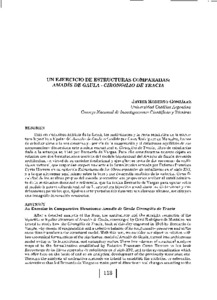Por favor, use este identificador para citar o enlazar este ítem:
https://repositorio.uca.edu.ar/handle/123456789/19108| Título: | Un ejercicio de estructuras comparadas: Amadía de Gaula - Cirongilio de Tracia | Autor: | González, Javier Roberto | Palabras clave: | ANALISIS LITERARIO; ANALISIS COMPARATIVO; ANALISIS ESTRUCTURAL; LIBROS DE CABALLERIA | Fecha de publicación: | 2005 | Editorial: | Universidad Católica Argentina. Facultad de Filosofía y Letras | Resumen: | Tras un minucioso análisis de la forma, las motivaciones y la recta semántica de la estructura bipartita o bipolar del Amadís de Gaula refundido por Garci Rodríguez de Montalvo, hemos de estudiar cómo a la vez conserva y —por vía de la exageración y el defectuoso equilibrio de sus componentes— distorsiona este modelo estructural el Cirongilio de Tracia, libro de caballerías dado a la estampa en 1545 por Bernardo de Vargas. Para ello consideramos nuestro objeto en relación con dos formulaciones teóricas del modelo hipotextual del Amadís de Gaula devenido architextual en virtud de su carácter fundacional y ejemplar; se trata de dos esquemas de análisis estructural, que responden respectivamente a la formalización sentada por Federico Francisco Curto Herrero en su opúsculo Estructuras de los libros españoles de caballerías en el siglo XVI, y a la que ofrecemos aquí mismo sobre la base y por desarrollo analítico de la anterior. Como finalidad de los análisis propios del método contrastivo nos proponemos arribar al establecimiento de la motivación doctrinal o referencial que ha tenido Bernardo de Vargas para operar sobre el modelo hipotextual/architextual de la estructura bipartita amadisiana las distorsiones y modificaciones parciales que, fijados e interpretados debidamente sus alcances últimos, constituyen una innegable innovación semántica. After a detailed analysis of the form, the motivations and the straight semantics of the bipartite or bipolar structure of Amadís de Gaula, rearranged by Garci Rodríguez de Montalvo, we intend to study how the Cirongilio de Tracia, book of chivalry engraved in 1545 by Bernardo de Vargas, —by means of exaggeration and a defective balance of its components— preserves and at the same time transforms the structural model. With this aim, we consider our object in relation with two theoretical formulations of the hipotextual model of Amadís de Gaula, turned into architextual model owing to its foundational and exemplary status. These two schemes of structural analysis respond to the formalization established by Federico Francisco Curto Herrero in his book Estructuras de los libros españoles de caballerías en el siglo XVI, and to the systematization which we offer here on the basis of and as an analytical development of the previously mentioned one. Through the analysis of contrastive methods we intend to establish the doctrinal or referential motivations that led Bernardo de Vargas to make partial distortions and changes according to the hipotextual/architextual model of the bipartite structure in Amadís. These, once fixed and interpreted in its ultímate consequences, constitute an undeniable semantic innovation. |
URI: | https://repositorio.uca.edu.ar/handle/123456789/19108 | ISSN: | 2683-7897 (online) 0326-3363 (impreso) |
Disciplina: | LITERATURA | Derechos: | Atribución-NoComercial-CompartirIgual 4.0 Internacional | Fuente: | Letras. 50-51, 2004-2005. |
| Aparece en las colecciones: | LETRAS - 2004-2005 nro. 50-51 |
Ficheros en este ítem:
| Fichero | Descripción | Tamaño | Formato | |
|---|---|---|---|---|
| ejercicio-estructuras-comparadas.pdf | 759,01 kB | Adobe PDF |  Visualizar/Abrir |
Este ítem está sujeto a una Licencia Creative Commons

